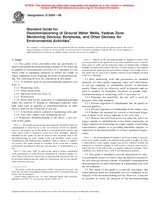Potrebujeme váš súhlas na využitie jednotlivých dát, aby sa vám okrem iného mohli ukazovať informácie týkajúce sa vašich záujmov. Súhlas udelíte kliknutím na tlačidlo „OK“.
ASTM D5299-99
Standard Guide for Decommissioning of Ground Water Wells, Vadose Zone Monitoring Devices, Boreholes, and Other Devices for Environmental Activities
Automaticky preložený názov:
Štandardné Príručka pre vyraďovanie podzemnej vody Wells , Vados zóny monitorovacích zariadení , vrtov a iné zariadenia pre aktivity v oblasti životného prostredia
NORMA vydaná dňa 10.12.1999
Informácie o norme:
Označenie normy: ASTM D5299-99
Poznámka: NEPLATNÁ
Dátum vydania normy: 10.12.1999
Kód tovaru: NS-30643
Počet strán: 16
Približná hmotnosť: 48 g (0.11 libier)
Krajina: Americká technická norma
Kategória: Technické normy ASTM
Anotácia textu normy ASTM D5299-99 :
Keywords:
Abandonment, Borehole, Decommissioning, Environmental control/fate, Geoenvironmental applications, Ground water, Hazardous waste, Injection wells, Monitoring wells, Observation wells, Plugging, Vadose zone, Waste materials/processing, Wells, decommissioning-ground water wells/vadose zone monitoring, devices/boreholes/other devices for environmental activities, guide, ICS Number Code 93.025 (External water conveyance systems)
Doplňujúce informácie
| 1. Scope | ||||||||||||
|
1.1 This guide covers procedures that are specifically related to permanent decommissioning (closure) of the following as applied to environmental activities. It is intended for use where solid or hazardous materials or wastes are found, or where conditions occur requiring the need for decommissioning. The following devices are considered in this guide: 1.1.1 A borehole used for geoenvironmental purposes (see Note 1), 1.1.2 Monitoring wells, 1.1.3 Observation wells, 1.1.4 Injection wells (see Note 2), 1.1.5 Piezometers, 1.1.6 Wells used for the extraction of contaminated ground water, the removal of floating or submerged materials other than water such as gasoline or tetrachloroethylene, or other devices used for the extraction of soil gas, 1.1.7 A borehole used to construct a monitoring well, and 1.1.8 Any other vadose zone monitoring device. 1.2 Temporary decommissioning of the above is not covered in this guide. Note 1-This guide may be used to decommission boreholes where no contamination is observed at a site (see Practice D420 for details); however, the primary use of the guide is to decommission boreholes and wells where solid or hazardous waste have been identified. Methods identified in this guide can also be used in other situations such as the decommissioning of water supply wells and boreholes where water contaminated with nonhazardous pollutants (such as nitrates or sulfates) are present. This guide should be consulted in the event that a routine geotechnical investigation indicates the presence of contamination at a site. Note 2-The term "well" is used in this guide to denote monitoring wells, piezometers, or other devices constructed in a manner similar to a well. Some of the devices listed such as injection and extraction wells can be decommissioned using this guide for information, but are not specifically covered in the text. Note 3-Details on the decommissioning of multiple-screened wells are not provided in this guide due to the many methods used to construct these types of wells and the numerous types of commercially available multiple-screened well systems. However, in some instances, the methods presented in this guide may be used with few changes. An example of how this guide may be used is the complete removal of the multiple-screened wells by overdrilling.1.3 Most monitoring wells and piezometers are intended primarily for water quality sampling, water level observation, or soil gas sampling, or combination thereof, to determine quality. Many wells are relatively small in diameter (<4-in. (10.1 cm) inside diameter) and are used to monitor for hazardous chemicals in ground water. Decommissioning of monitoring wells is necessary to: 1.3.1 Eliminate the possibility that the well is used for purposes other than intended, 1.3.2 Prevent migration of contaminants into an aquifer or between aquifers, 1.3.3 Prevent migration of contaminants in the vadose zone, 1.3.4 Reduce the potential for vertical or horizontal migration of fluids in the well or adjacent to the well, and 1.3.5 Remove the well from active use when the well is no longer capable of rehabilitation, or has failed structurally; no longer required for monitoring; no longer capable of providing representative samples or is providing unreliable samples; or required to be decommissioned; or to meet regulatory requirements. Note 4-The determination of whether a well is providing a representative water quality sample is not defined in this guide. Examples of when a representative water quality sample may not be collected include the biological or chemical clogging of well screens, a drop in water level to below the base of the well screen, or complete silting of a tail pipe. These conditions may indicate that a well is not functioning properly.1.4 This guide is intended to provide information for effective permanent closure of wells so that the physical structure of the well does not provide a means of hydraulic communication between aquifers or react chemically in a detrimental way with the environment. 1.5 The intent of this guide is to provide procedures that when followed result in a reasonable level of confidence in the integrity of the decommissioning activity. However, it may not be possible to verify the integrity of the decommissioning procedure. At this time, methods are not available to substantially determine the integrity of the decommissioning activity. 1.6 The values stated in inch-pound units are to be regarded as the standard. The SI units given in parentheses are for information only. 1.7 This standard does not purport to address all of the safety problems, if any, associated with its use. It is the responsibility of the user of this standard to establish appropriate safety and health practices and determine the applicability of regulatory limitations prior to use. Note 5-If state and local regulations are in effect where the decommissioning is to occur, the regulations take precedence over this guide. |
||||||||||||
| 2. Referenced Documents | ||||||||||||
|
Odporúčame:
Aktualizácia technických noriem
Chcete mať istotu, že používate len platné technické normy?
Ponúkame Vám riešenie, ktoré Vám zaistí mesačný prehľad o aktuálnosti noriem, ktoré používate.
Chcete vedieť viac informácií ? Pozrite sa na túto stránku.




 Cookies
Cookies
